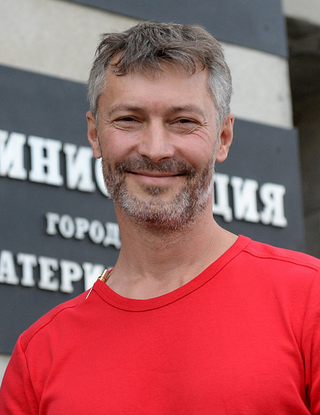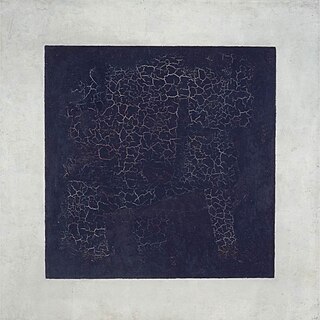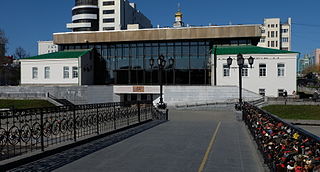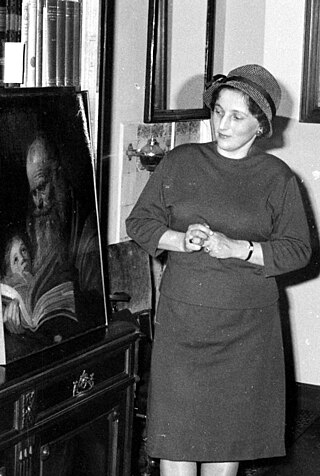
An icon is a religious work of art, most commonly a painting, in the cultures of the Eastern Orthodox, Oriental Orthodox, and Catholic churches. They are not simply artworks; "an icon is a sacred image used in religious devotion". The most common subjects include Christ, Mary, saints and angels. Although especially associated with portrait-style images concentrating on one or two main figures, the term also covers most of the religious images in a variety of artistic media produced by Eastern Christianity, including narrative scenes, usually from the Bible or the lives of saints.

Yekaterinburg, alternatively romanized as Ekaterinburg and formerly known as Sverdlovsk, is a city and the administrative centre of Sverdlovsk Oblast and the Ural Federal District, Russia. The city is located on the Iset River between the Volga-Ural region and Siberia, with a population of roughly 1.5 million residents, up to 2.2 million residents in the urban agglomeration. Yekaterinburg is the fourth-largest city in Russia, the largest city in the Ural Federal District, and one of Russia's main cultural and industrial centres. Yekaterinburg has been dubbed the "Third capital of Russia", as it is ranked third by the size of its economy, culture, transportation and tourism.

Sverdlovsk Oblast is a federal subject of Russia located in the Ural Federal District. Its administrative center is the city of Yekaterinburg, formerly known as Sverdlovsk. Its population is 4,268,998.

The Frans Hals Museum is a museum located in Haarlem, the Netherlands.

The State Russian Museum, formerly the Russian Museum of His Imperial Majesty Alexander III, on Arts Square in Saint Petersburg, is the world's largest depository of Russian fine art. It is also one of the largest art museums in the world with total area over 30 hectares. In 2022 it attracted 2,651,688 visitors, ranking twelfth on list of most-visited art museums in the world.

Mikhail Vasilyevich Nesterov was a Russian and Soviet painter; associated with the Peredvizhniki and Mir Iskusstva. He was one of the first exponents of Symbolist art in Russia.

The Leaning Tower of Nevyansk is a tower in the town of Nevyansk in Sverdlovsk Oblast, Russia, built in the 18th century. Its construction was funded by the blacksmith and industrialist Nikita Demidov and later his son Akinfiy Demidov, a famous Russian manufacturer and an associate of Peter the Great.

The Cathedral of St. Sophia, the Holy Wisdom of God in Veliky Novgorod, Russia, is the cathedral church of the Metropolitan of Novgorod and the mother church of the Novgorodian Eparchy.

Vladimir Lukich Borovikovsky was a prominent Russian Imperial artist of Ukrainian Cossack background, who served at the court of Catherine the Great and dominated portraiture in the Russian Empire at the turn of the 19th century.

Kuzma Sergeevich Petrov-Vodkin, was a Russian and Soviet painter. His early iconographic work used special creative effects based on the curve of the globe, but its images were considered blasphemous by the Russian Orthodox Church. However he went on to become the first president of the Leningrad Union of Soviet Artists. His autobiographical writings attracted much praise, and have enjoyed a later revival.

The use and making of icons entered Kievan Rus' following its conversion to Orthodox Christianity in AD 988. As a general rule, these icons strictly followed models and formulas hallowed by Byzantine art, led from the capital in Constantinople. As time passed, the Russians widened the vocabulary of types and styles far beyond anything found elsewhere in the Orthodox world.

Ivan Petrovich Argunov was a Russian painter, one of the founders of the Russian school of portrait painting.

The Trinity is an icon created by Russian painter Andrei Rublev in the early 15th century. It is his most famous work and the most famous of all Russian icons, and it is regarded as one of the highest achievements of Russian art. Scholars believe that it is one of only two works of art that can be attributed to Rublev with any sort of certainty.

Yevgeny Vadimovich Roizman is a Russian opposition politician who served as the mayor of Yekaterinburg from 2013 to 2018. He campaigned against corrupt police, illegal drug sellers and for drug rehabilitation centers.

"Autograph" Gallery is an informal gallery of contemporary art composed of a collection of miniature paintings, drawings and sculptures. It was founded by gallery owner Tatiana Nabrosova-Brusilovskaya in December 1993.

Black Square is an iconic 1915 painting by Kazimir Malevich. The first version was done in 1915. Malevich made four variants of which the last is thought to have been painted during the late 1920s or early 1930s. Black Square was first shown in The Last Futurist Exhibition 0,10 in 1915. The work is frequently invoked by critics, historians, curators, and artists as the "zero point of painting", referring to the painting's historical significance and paraphrasing Malevich.

Pyotr Petrovich Vereshchagin was a Russian landscape and cityscape painter in the Academic style. He was the first to paint plein-air in the wilderness of the Urals.

The Yekaterinburg Museum of Fine Arts, established in 1986, is the largest art museum of the Urals region of Russia. It is based in Voevodina Street on the banks of the Iset River in the city of Yekaterinburg.

Irina Vladimirovna Linnik was a prominent Russian art historian. Considered an icon in Dutch art history and a leading specialist in Western European painting, Linnik's work was mainly concerned with the identification and attribution of 17th-century paintings from the Low Countries, France and Italy. Over the course of her career she identified, attributed and re-attributed around 250 different paintings.